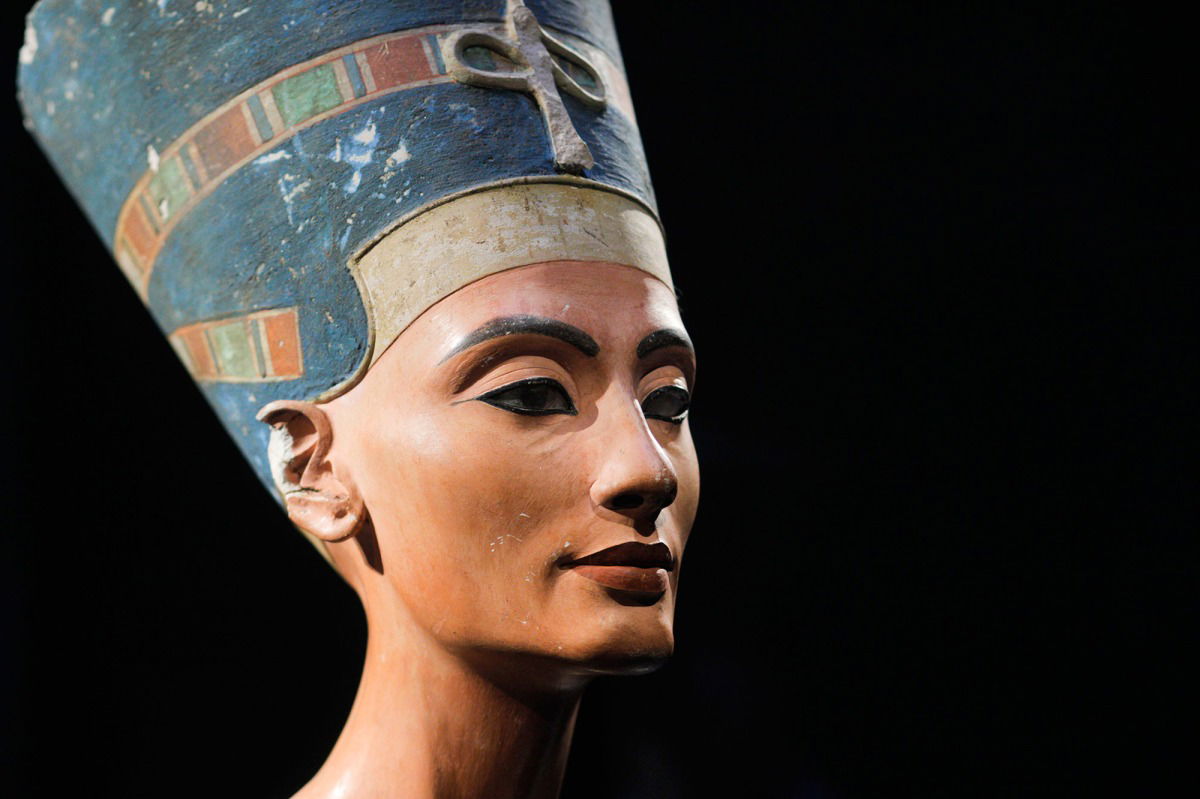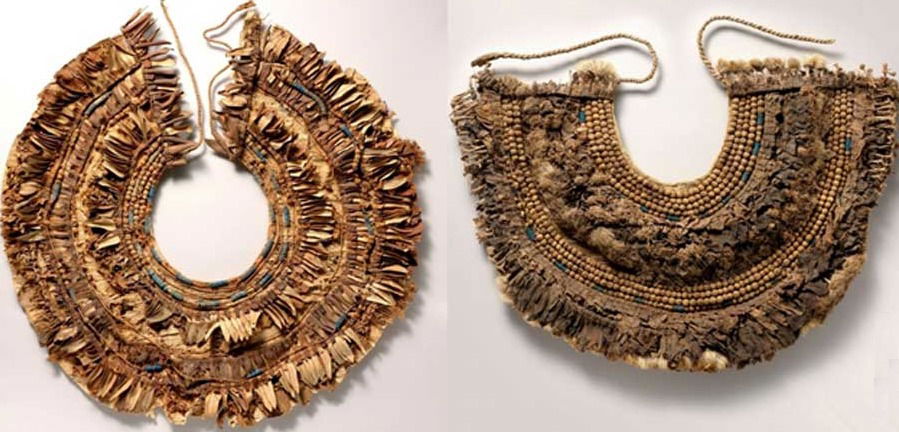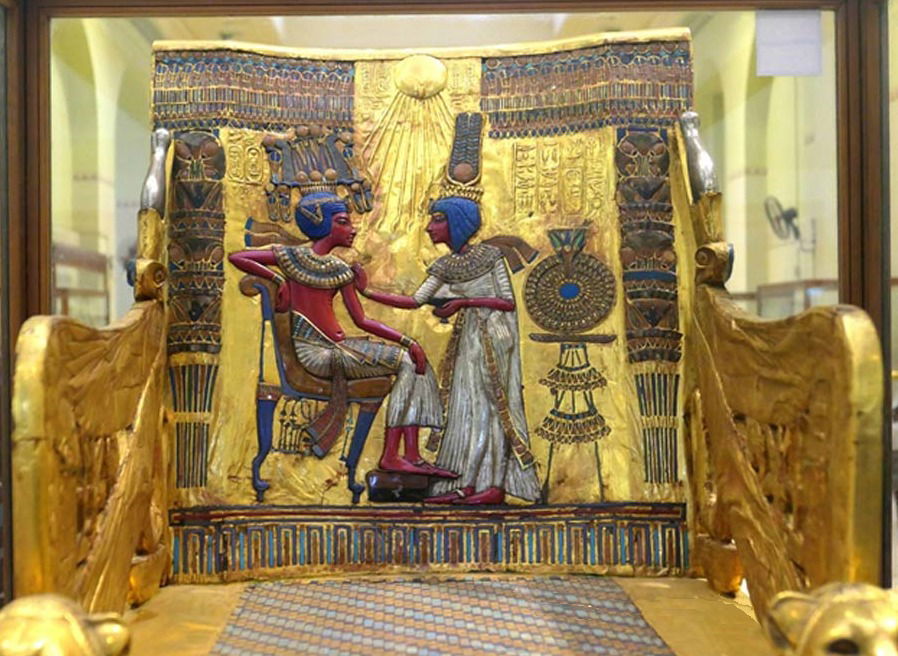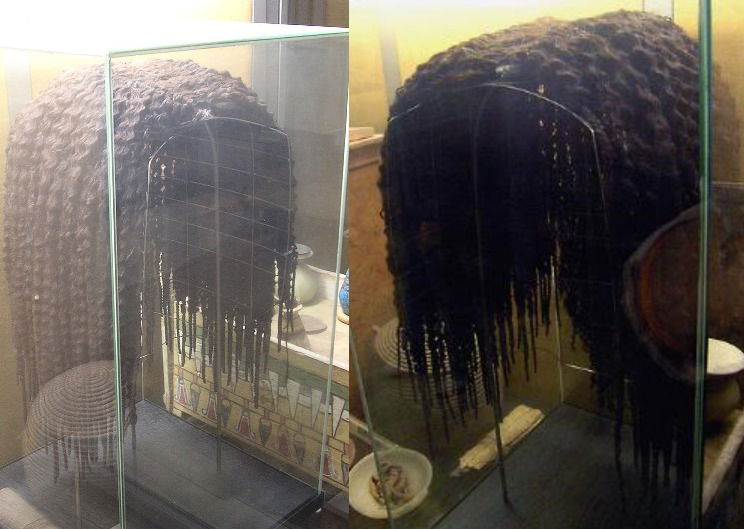Comparative dispositions: WHERE IS THE ‘CHILDLESS’ PHARAOH’S WIFE’S MOTHER, NEFERTITI?*
Dr. Zahi Hawass and Dr. Nicholas Reeves have yet to reach a decision on the whereabouts of Tutankhamen’s wife’s mother, Nefertiti. The discussion has been at loggerheads since July 2015 when Dr. Reeves introduced a theory suggesting that Nefertiti was buried alongside Tutankhamen in an annex chamber. This type of dispute has developed because there are many ‘names’ [1] and too few likely mummies (and their tombs)** to account for all the named people in this ‘New Kingdom’, 18th Dynasty, Royal family. Many theories postulated by Egyptologists provide more than one name for the same person. Gender, also, does not deter Egyptologists in their pursuit to name and locate all ‘imagined’ people existing in Ancient Egypt; female kings are the best example. However, conversely, there have been no male queens identified. Similarly, cached tombs with multiple numbers of occupants have been discovered - as ancient reburial locations. [1]
Dr. Nicholas Reeves’ thought and approach concerning a theory for the identification and burial site location of Nefertiti is wrong, argues Dr. Zahi Hawass. To begin his decent Dr. Hawass argues (‘impulsively’ - News Network Archaeology (archive (305) Dec. 2015) that Ay [2] [3]a., was the intended occupant for ‘Tomb KV 62’ (1922). Ay’s mummified remains have been identified as those found in ‘Tomb WV 23’ (1816) - with no sign in this tomb of the mummified remains of Nefertiti, who is presumed to be the daughter of Ay. Therefore, Nefertiti is a likely candidate for an annex chamber location in Tutankhamen’s tomb - following Dr. Hawass’ claim. However, conflictingly, Dr. Reeves postulates that Nefertiti is the same person as Smenkhkare [4] (a sibling of Tutankhamen - as a female sibling and not a male sibling). Akhenaten’s child not a child of Ay. Smenkhkare was the immediate successor to Akhenaten before the reign of Tutankhamen; for this reason, the ‘burial chamber’ of ‘Tomb KV 62’ (1922) - it can be assumed a sealed tomb, ‘complete’ (Cir. 1334 BC) - would have been occupied before the death of Tutankhamen (Cir. 1323 BC). Which does not appear to be the case? Conflictingly, the mummified remains of Ay have been identified as the mummy from (a very early contemporarily discovered tomb, of 1816) ‘Tomb WV 23’ (1816). However, the mummified remains of Nefertiti and a site location - or site reburial locations - for Nefertiti have yet to be identified.
Because Nefertiti’s burial would have taken place during the ‘period’ of the Amarna heresy. It is likely that a reburial has taken place which (among several known site options, placing Nefertiti’s mummy with mummy ‘KV 21A’) has repositioned her burial to that of (a very early contemporarily discovered tomb, of 1817) ‘Tomb KV 21’ (1817) in the valley of the Kings [2] [5] as one of the two female mummies - most possibly as mummy ‘KV 21B’. [3]a. In Feb. 2010, Dr. Zahi Hawass et al [6] ‘disproved’ - with the aid of DNA analysis - the assumption that the mummified remains of Nefertiti were stored with the ‘reburial cache of mummies’ in (an early contemporarily discovered tomb, of 1898) ‘Tomb KV 35’ (1898). Further, Dr. Zahi Hawass et al have shown that any familial relationship between mummy ‘KV 21B’ and mummy ‘KV 21A’ is imaged rather than medically true - mummy ‘KV 21B’ is not the ‘biological mother’ of mummy ‘KV 21A’. Questioning the validity of the theory that Nefertiti was one of the mummies discovered in ‘Tomb KV 21’ (1817) - if one mummy is correctly identified then the other mummy cannot be correctly identified. Further, any time frame, including the date of the death of Nefertiti, given for the burial of Tutankhamen’s mother-in-law and the assumed events of her life have yet to be explained. Therefore, validating an explanation, because of a lack of archaeological evidence - that Nefertiti’s burial site location (and a more than likely reburial site location) has yet to date (‘May 2019’) to be - from the extant site location and documented options available - identified. Similarly, there has yet to be established confirmation (through comparative DNA examples) to provide for an ‘ongoing index reference structure’ between several ‘available’ (a ‘Mutnedjmet’ or similarly another, ‘Mutbenret’ - ‘sister of Nefertiti’) [2] mummies, as to the identity of Nefertiti’s remains from among today’s ‘known mummies’ - DNA examples from both those mummies which have been provisionally identified (assumed family members) and from unidentified extant mummified remains. Therefore, to hypothesis with physical accountability, leaving to one side the unknown from any future DNA options from the discovery of today’s ‘missing’ and the inevitable yet to be reidentified ‘wrongly labelled’ mummified remains.
Nefertiti could still be buried in Amarna (in an unknown Royal Tomb: known Royal Tombs are empty and her original burial location has not been established) [2] because of the ‘period’ of the Amarna heresy beginning with her husband Akhenaten (whose mummy is thought, by Egyptologists, to have been found in ‘Tomb KV 55’ (1907) [1] having been moved from Amarna along with his mother, Queen Tiye (‘The Elder Lady’). Queen Tiye is thought to have been finally relocated - yet again, from Amarna to ‘Tomb KV 55’ (1907) to ‘Tomb KV 35’ (1898) to be in a cache of mummies, one of which was Queen Tiye’s husband and father of Akhenaten, Amenhotep III) and the unsystematic approach to subsequent political adjustments made through the implementation of traditional Egyptian religious ‘rite of passage’ practises by proceeding administrations; beginning with Tutankhamen and ending with Horemheb. Further, several busts of Nefertiti were found in Amarna, in 1912.
In Dr. Reeves’ deference and for the reasons of philosophical logic: until Nefertiti’s remains are identified - now, and in the foreseeable future - it is an ‘open season’, in the discussion by Egyptologists and other interested parties, as to the ‘present location’ of Nefertiti’s remains; and in the theoretical computation of the many ‘available’ options of mummy ‘DNA choice examples’ for the process of further analysis, hypothesis and discussion.
The ‘childless’ Ancient Egyptian, New Kingdom, 18th Dynasty, Royal couple - Tutankhamen and his, well-known, wife Ankhesenamen - are each, individually and together, as a couple, a good ‘point of reference’ for the observations given by various Egyptologists in their individual theories that ‘determine’ the relationship and behaviour between these New Kingdom, Ancient Egyptians and their extended family:*** further, the tomb (‘shaft-pit’) of Tutankhamen’s embalming (waste) cache, ‘Tomb KV 54’ (1907); Tutankhamen’s tomb, ‘Tomb KV 62’ (1922, Howard Carter’s discovery); and the ‘New Kingdom’ cache tomb of embalming waste, ‘Tomb KV 63’ (2005) are among some of the most interesting archaeological site location discoveries for contemporary archaeologists and anthropologists to investigate - in the field of Egyptology - in their search for the physical characteristics and psychological profiles of this ‘childless’ Ancient Egyptian, New Kingdom, 18th Dynasty, Royal couple; when - as a ‘point of reference’ - the ‘‘childless’ couple’ are appraised (in chronological structures of time, location and physical possibilities) both as individual and spouse, for their comparative relationship with the ‘accumulated’ and documented archaeological evidence.
No. [1.5] The ‘Bust of Nefertiti’ from ‘Amarna’ (1912) - (Archaeology newsnetwork.blogspot.com)

No. [2.5] Floral collars from ‘Tomb KV 54’ (1907) - (Ancient origins.net)

No. [3.5] ‘Golden Throne of Tutankhamen’ from ‘Tomb KV 62’ (1922) - (Ancient origins.net)

No. [4.5] The 18th Dynasty wig owned by Merit, discovered ‘boxed and in good condition’, from ‘Tomb TT 8’ (1906) - (a). (On the left side) - (Wikimedia.org); and b). (On the right side) - (Deir el-medina.com)

No. [5.5] ‘Coffin A’ - an 18th Dynasty anthropomorphic (anthropoid) coffin, from ‘Tomb KV 63’ (2005) - (Egypte xsbb.nl)

Tomb references mentioned in the text (for the URL links’ list see, ‘Source URLs’, below) [7]:
a. ‘Tomb KV 21’ - Two unnamed mummies (thought to be two 18th Dynasty Queens) - (1817) Valley of the Kings, Egypt - discovered by the Italian archaeologist Giovanni Battista Belzoni. [3]a. [5]
b. ‘Tomb KV 35’ - A cache of 18th Dynasty mummies stored in the tomb of Amenhotep II which includes Queen Tiye, ‘The Elder Lady’ and her husband, Amenhotep III (1898) Valley of the Kings, Egypt - discovered by the French archaeologist Victor Loret.
c. ‘Tomb KV 54’ - Tutankhamen’s embalming (waste) cache (thought to be part of ‘Tomb KV 62’ (1922) and ‘Tomb KV 63’ (2005) as an overflow of waste items) - (1907) Valley of the Kings, Egypt - discovered by the English archaeologist Edward R, Ayrton, for the American lawyer Theodore M. Davis. The archaeological finds are held at the Metropolitan Museum of Art in New York City.
d. ‘Tomb KV 55’ - Akhenaten - (‘Tomb KV 55’ (1907) - contained the mummified remains of Akhenaten - or possibly, with some reservations of gender, ‘Smenkhkare’ - see, Dr. Hawass et al, Feb. 2010) [6] - both Akhenaten and Smenkhkare are thought to be closely related to ‘Tutankhamen’. This tomb is also closely connected to ‘Tomb KV 35’ (1898) by Egyptologists; four canopic jars found in the tomb are thought to belong to ‘Kiya’, a suggested mother for Tutankhamen) - (1907) Valley of the Kings, Egypt - discovered by English archaeologist Edward R. Ayrton, for the American lawyer Theodore M. Davis.
e. ‘Tomb KV 62’ - Tutankhamen (1922) Valley of the Kings, Egypt - discovered by the English archaeologist Howard Carter, for the English peer Lord Carnarvon.
f. ‘Tomb KV 63’ - The ‘New Kingdom’ cache of embalming waste (thought to be part of ‘Tomb KV 54’ (1907) and ‘Tomb KV 62’ (1922) as an overflow of waste items) - (2005) Valley of the Kings, Egypt - discovered by the American archaeologist Dr. Otto John Schaden, for the University of Memphis, Tennessee, USA.
g. ‘Tomb WV 23’ - Ay (this tomb’s decoration is similar in content and colour to that of Tutankhamun’s tomb, ‘Tomb KV62’ (1922) - ) - (1816) Western Valley of the Kings, Egypt - discovered by the Italian archaeologist Giovanni Battista Belzoni.
Some further ‘associative tomb’ references (for the URL links’ list see, ‘Source URLs’, below) [8]:
a. ‘Tomb KV 46’ - Yuja and his wife Tjuyu (the parents of ‘Queen Tiye’ - see, ‘Tomb KV 35’ (1898) - ) - (1905) Valley of the Kings, Egypt - discovered by the British Egyptologist James E. Quibell, for the American Lawyer Theodore M. Davis.
b. ‘Tomb KV 57’ - Horemheb (1908) Valley of the Kings, Egypt - discovered by the English archaeologist Edward R. Ayrton, for the American Lawyer Theodore M. Davis.
c. ‘Tomb KV 64’ - An 18th Dynasty reburial (2011) Valley of the Kings, Egypt - discovered by Dr. Elina Paulin-Grothe of the University of Basel, Switzerland.
d. ‘Tomb of Maya’ - Maya and his wife Merit (an important 18th Dynasty court administrator) - (1843) Saqqara, Egypt - discovered by Prussian archaeologist Karl Richard Lepsius.
e. ‘Tomb of Nebamun’ - Nebamun (an 18th Dynasty temple scribe) - (1820) Theban Necropolis, Egypt - discovered by a young Greek, Giovanni Yanni d’Athanas, for the British ‘collector of antiquities’ Henry Salt.
f. ‘Tomb TT 8’ - Kha and his wife Merit (1906) Deir el-Medina (worker’s town) Theban Necropolis, Egypt - discovered by the English archaeologist Arthur Weigall and Italian archaeologist Ernesto Shiaparelli, for the Italian Archaeological Mission. Most of the finds are held in the Egyptian Museum in Turin, Italy; some of which have been dated to the Middle Kingdom (with notable reservations) for this New Kingdom tomb.
Text source URLs and numbered article references:
Akhet.co.uk - ‘Tutankhamun (/en): The Boy King’ - (web-site: a history of Tutankhamen and Ancient Egypt) - http://www.akhet.co.uk/tutankh.htm
[2] Archaeology newsnetwork.blogspot.com - News Network Archaeology (archive (305) Dec. 2015): Zahi Hawass - ‘Nefertiti Tomb Theory ‘Baseless’’ (Original source: The Sunday Telegraph - Magdy Samaan, 27th Dec. 2015) - https://archaeologynewsnetwork.blogspot.com/2015/12/zahi-hawass-nefertiti-tomb-theory.html?utm_source=feedburner&utm_medium=feed&utm_campaign=Feed:+TheArchaeologyNewsNetwork+(The+Archaeology+News+Network)#.VoQvPE-SP1s#w8jHL30whjuyV1ql.97
Archaeology newsnetwork.blogspot.com - News Network Archaeology (archive (302) Apr. 2019): ‘Expansive ‘New Kingdom’ Tomb Unveiled in Egypt’s Luxor’ (Original source: Reuters - Mostafa Salem & Aidan Lewis, 20th Apr. 2019) - https://archaeologynewsnetwork.blogspot.com/2019/04/expansive-new-kingdom-tomb-unveiled-in.html#ZskeVIptdyyXZFGT.97
[6] JAMA Network.com - (‘Ancestry and Pathology in King Tutankhamun’s Family’ (17th Feb. 2010) Zahi Hawass, PhD; Yehia Z. Gad, MD; Somaia Ismail, PhD; et al - Article Information: JAMA. 2010;303(7): 638-647. doi:10.1001/jama.2010.121) - (for, Dr. Hawass’ et al CT scan images and DNA tables) - https://jamanetwork.com/journals/jama/fullarticle/185393
Jo marchant.com - Jo Marchant: journalist and author, ‘The discovery of tomb KV64’, Jo Marchant, 10th June 2015 - a. (a report of an account, by Susanne Bickel, about the University of Basel’s discovery of ‘Tomb KV 64’ (2011) - ) - https://jomarchant.com/422/the-discovery-of-tomb-kv64 | b. Jo Marchant: journalist and author, ‘The Shadow King: The bizarre afterlife of King Tut’s mummy’, Jo Marchant, Published in June 2013 - (a discussion about Tutankhamen’s mummy, from its first autopsy in 1925 to DNA testing in the twenty-first-century) - https://jomarchant.com/the-shadow-king
KV-63.com - ‘KV-63: Newly Discovered Tomb’, Dr. Otto John Schaden (Roxanne and Bill Wilson - February 2016) - (Otto Schaden’s Dig Diary: an account from his team’s discovery and excavation, of ‘Tomb KV 63’ (2005) - ) - http://www.kv-63.com/index.html
[5] News nationalgeographic.com - ‘Photo Album: King Tut, Queen Nefertiti, and One Tangled Family Tree: Archaeologists investigating the famous pharaoh’s tomb confront the mystery of his missing stepmother - Nefertiti’, National Geographic, A. R. Williams, 29th Sep. 2015 - (a slideshow of seven New Kingdom, 18th Dynasty mummies: of ‘seven close members’ of Tutankhamen’s immediate family, including the (available ‘remains’ of) mummy ‘KV 21A’ (thought to be Ankhesenamen, Tutankhamen’s wife) from ‘Tomb KV 21’ (1817) - ) - https://news.nationalgeographic.com/2015/09/150929-king-tut-tomb-nefertiti-egypt-archaeology/
[4] Nicholas Reeves, FSA (UK) - (‘The Burial of Nefertiti’, 23rd July 2015) - (URL link for PDF to download by Dr. Reeves, FSA) - https://www.academia.edu/14406398/The_Burial_of_Nefertiti_2015_
[3] Tim theegyptians.blogspot.com - ‘Egyptians’ - a. ‘The Truth in the Search for Nefertiti’, Timothy Reid, 30th Dec. 2015 - (‘a photograph of mummy ‘KV 21B’ from ‘Tomb KV 21’ (1817) and a discussion about the dispute between Dr. Zahi Hawass and Dr. Nicholas Reeves) - https://tim-theegyptians.blogspot.com/2015/12/the-truth-in-search-for-nefertiti.html | b. ‘The Mummy of Queen Tiye’, Timothy Reid, 22nd March 2011 - (information about and a picture image of, Queen Tiye and ‘Tomb KV 35’ (1898) - ) - https://tim-theegyptians.blogspot.com/2011/03/mummy-of-queen-tiyes.html | c. ‘The Daughters of Nefertiti’, Timothy Reid, 9th Oct 2015 - (a discussion about and picture images of, Nefertiti’s daughters and ‘Tomb KV 63’ (2005) - ) - https://tim-theegyptians.blogspot.com/2015/10/the-daughters-of-nefertiti_9.html
Wikipedia.org - a. Hawass, Z. - (‘Zahi Hawass’) - (for information: Dr. Zahi Hawass’ (زاهي حواس ، د.) bibliographical and biographical details) - https://en.wikipedia.org/wiki/Zahi_Hawass | b. Reeves, N. - (‘Nicholas Reeves’) - (for information: Dr. Nicholas Reeves’ bibliographical and biographical details) - https://en.wikipedia.org/wiki/Nicholas_Reeves
[1] Wikipedia .org - (‘KV55’) - (‘Tomb KV 55’ (1907) - contained the mummified remains of Akhenaten - or possibly, with some reservations of gender, ‘Smenkhkare’ - see, Dr. Hawass et al, Feb. 2010) [6] - both Akhenaten and Smenkhkare are thought to be closely related to ‘Tutankhamen’. This tomb is also closely connected to ‘Tomb KV 35’ (1898) by Egyptologists; four canopic jars found in the tomb are thought to belong to ‘Kiya’, a suggested mother for Tutankhamen) - (1907) Valley of the Kings, Egypt - discovered by English archaeologist Edward R. Ayrton, for the American lawyer Theodore M. Davis) - https://en.wikipedia.org/wiki/KV55
[7] Wikipedia.org - URLs for the tomb references mentioned in the text: a. https://en.wikipedia.org/wiki/KV21 | b. https://en.wikipedia.org/wiki/KV35 | c. https://en.wikipedia.org/wiki/KV54 | d. https://en.wikipedia.org/wiki/KV55 | e. https://en.wikipedia.org/wiki/KV62 | f. i. https://en.wikipedia.org/wiki/KV63 | f. ii. (Otto Schaden’s Dig Diary) - http://www.kv-63.com/index.html | g. https://en.wikipedia.org/wiki/WV23
[8] Wikipedia.org - Some further (‘helpful Wikipedia.org’ URL) ‘associative tomb’ references: a. https://en.wikipedia.org/wiki/KV46 | b. https://en.wikipedia.org/wiki/KV57 | c. https://en.wikipedia.org/wiki/KV64 | d. https://en.wikipedia.org/wiki/Maya_(treasurer) | e. https://en.wikipedia.org/wiki/Tomb_of_Nebamun | f. https://en.wikipedia.org/wiki/TT8
Source URLs for the picture images No. [1.5] - No. [5.5] and further ‘artefact’ source URLs:
No. [1.5] The ‘Bust of Nefertiti’ from ‘Amarna’ (1912) - (Archaeology newsnetwork.blogspot.com)
Ancient egypt.online.com - ‘Nefertiti’s Bust’ - (the ‘Bust of Nefertiti’ (1912) - ) - https://www.ancient-egypt-online.com/nefertiti-bust.html
Ancient origins.net - a. ‘Bust of Contention: Controversy erupts as the Younger Lady (Tutankhamen’s mother - possibly named ‘Kiya’, discovered in ‘Tomb KV 35’ (1898) - ) is dubbed Nefertiti - Part I’, Anand Balaji, 11th Feb. 2018 - https://www.ancient-origins.net/news-history-archaeology/bust-contention-controversy-erupts-younger-lady-dubbed-nefertiti-part-i-021825 |b. ‘Bust of Contention: Nefertiti’s sculpture raises issues of Race and Color (Colour) - Part II’, Anand Balaji, 11th Feb. 2018 - (the ‘Bust of Nefertiti’ (1912) - ) - https://www.ancient-origins.net/news-history-archaeology/bust-contention-nefertiti-s-sculpture-raises-issues-race-and-color-part-ii-021826
Archaeology newsnetwork.blogspot.com - Archaeology News Network (archive (305) Dec. 2015): Zahi Hawass - ‘Nefertiti Tomb Theory ‘Baseless’’ (Original source: The Sunday Telegraph - Magdy Samaan, 27th Dec. 2015) - (picture image used: the ‘Bust of Nefertiti’ (1912) - ) - https://archaeologynewsnetwork.blogspot.com/2015/12/zahi-hawass-nefertiti-tomb-theory.html?utm_source=feedburner&utm_medium=feed&utm_campaign=Feed:+TheArchaeologyNewsNetwork+(The+Archaeology+News+Network)#.VoQvPE-SP1s#w8jHL30whjuyV1ql.97
Egyptian museum-berlin.com - ‘Society for the Promotion of the Egyptian Museum Berlin’ - Level 2, Nefertiti - Room 2.10: ‘Bust of Queen Nefertiti’ - (the ‘Bust of Nefertiti’ (1912) - ) - http://www.egyptian-museum-berlin.com/c53.php
Wikipedia.org - (‘Nefertiti Bust’) - (the ‘Bust of Nefertiti’ (1912) - ) - https://en.wikipedia.org/wiki/Nefertiti_Bust
No. [2.5] Floral collars from ‘Tomb KV 54’ (1907) - (Ancient origins.net)
‘Floral collars recovered from ‘Tomb KV 54’ (1907) Tutankhamen’s embalming cache, were made up of an array of flowers and materials such as: papyrus, olive leaves, persea leaves, cornflowers, blue lotus petals, picris flowers, nightshade berries, faience and linen. Davis/Ayrton excavations, 1907 (Metropolitan Museum of Art, New York)’ - (Ancient origins.net)
Ancient origins.net - ‘When Tutankhamun (/en) Lay in State: Do Floral Collars Hint at (a) Sinister Turn of Events? - Part II’, Anand Balaji, 23rd Jan. 2019 - (picture image and accompanying text used: floral collars from ‘Tomb KV 54’ (1907) - ) - https://www.ancient-origins.net/history/tutankhamun-lay-state-0011371
Metropolitan museum.org - ‘Floral collars from Tutankhamun’s (/en’s) Embalming Cache, ca. 1336-1327 B.C.’ - The Met fifth Avenue in Gallery 122 - Also see, READ MORE, click on ‘jars’ for: ‘Large Storage Jar from Tutankhamun’s Embalming Cache, ca. 1336-1327 B.C.’ - then go to, ‘Curatorial Interpretation’, C. H. Roehrig 2019 - (floral collars from ‘Tomb KV 54’ (1907) - ) - https://www.metmuseum.org/art/collection/search/684769
Wikimedia.org - (‘Category: Floral collars of Tutankhamun (/en)’) - (floral collars from ‘Tomb KV 54’ (1907) - ) - https://commons.wikimedia.org/wiki/Category:Floral_collars_of_Tutankhamun
No. [3.5] ‘Golden Throne of Tutankhamen’ from ‘Tomb KV 62’ (1922) - (Ancient origins.net)
Akhet.co.uk - Akhet Egyptology: The Horizon to the Past - ‘Tomb Furniture’ - (Golden Throne of Tutankhamen from ‘Tomb KV 62’ (1922) - ) - http://www.akhet.co.uk/furnit.htm
Ancient origins.net - ‘When Tutankhamun (/en) Lay in State: Did Ankhesenamun (/en) Wilfully (Wilfully) Delay Her Husband’s Burial - Part I’, Anand Balaji, 21st Jan. 2019 - (picture image used: Golden Throne of Tutankhamen from ‘Tomb KV 62’ (1922) - a view of the inside back-rest) - https://www.ancient-origins.net/history/ankhesenamun-0011361
Egypt museum.com - a. (Golden Throne of Tutankhamen from ‘Tomb KV 62’ (1922) - a view of the inside back-rest) - https://egypt-museum.com/tagged/tutankhamun/page/11 | b. (Golden Throne of Tutankhamen from ‘Tomb KV 62’ (1922) - an isometric view) - https://egypt-museum.com/tagged/tutankhamun/page/15
Wikimedia.org - a. (‘Category: Gilded Wooden Throne of Tutankhamun (/en)’) - (Golden Throne of Tutankhamen from ‘Tomb KV 62’ (1922) - ) - https://commons.wikimedia.org/wiki/Category:Gilded_Wooden_Throne_of_Tutankhamun | b. (‘Category: Treasure of Tutankhamun (/en)’) - (Golden Throne of Tutankhamen from ‘Tomb KV 62’ (1922) - ) - https://commons.wikimedia.org/wiki/Category:Treasure_of_Tutankhamun
No. [4.5] The 18th Dynasty wig owned by Merit, discovered ‘boxed and in good condition’, from ‘Tomb TT 8’ (1906) - (a). (On the left side) - (Wikimedia.org); and b). (On the right side) - (Deir el-medina.com)
Ancient origins.net - ‘Changing Beauty: The Use of Elaborate Wigs in Ancient Egypt’, Natalia Klimczak - (Ancient Egyptian hairstyling) - https://www.ancient-origins.net/history-ancient-traditions/changing-beauty-use-elaborate-wigs-ancient-egypt-005484
Deir el-medina.com - ‘Turin Museum: the tomb of Kha’, Lenka Peacock, Dec. 2017 - (this web-site contains ‘bibliographic information’ (see, the PDFs: esp. 9., R. Bianucci et al (‘sic.’) of 2015 [(QV36) : (KV46)] :: [medial and lateral] :: [cerebellum, cerebration, evisceration, cerebral and phlebotomy]) for two 18th Dynasty tombs: ‘Tomb TT 8’ (1906) and ‘Tomb KV 46’ (1905) - ) - (picture image used: b). (On the right side) Merit’s wig from ‘Tomb TT 8’ (1906) - ) - http://www.deirelmedina.com/lenka/TurinKha.html
Egyptian occulthistory.blogspot.com - Egyptian Occult History - Lecture: ‘The history of wigs in Ancient Egypt’, 30th Jan. 2018 (sic. [In the web-site picture images: ‘Princess Nsikhonsu’ - the mummy does not appear to be the female mummy Nsikhonsu/ ‘Neskhons’, of the 21st Dynasty] see, b. for photograph details) - a. (Ancient Egyptian hairstyling) - https://egyptianocculthistory.blogspot.com/2018/01/lecture-history-of-wigs-in-ancient-egypt.html?spref=pi&m=1 | b. (A Getty images.co.uk photograph: the mummy photograph is possibly of ‘Prince Ouabkhousenou’; a male mummy held at the ‘Cairo Museum, Egypt’ (the Egyptian Museum, Cairo) see, Getty images.co.uk - ‘Egypt’s Mummies’ - (‘CAIRO EGYPT: A mummy that is thought to be Prince Ouabkhousenou …’) - https://www.gettyimages.co.uk/detail/news-photo/mummy-that-is-thought-to-be-prince-ouabkhousenou-at-cairo-news-photo/76146689).
History embalmed.org - Egyptian Hairstyles, Siteseen Ltd, 2018 - (Ancient Egyptian hairstyling: also see, ‘Egyptian Wigs’) - http://www.historyembalmed.org/ancient-egyptians/egyptian-hairstyles.htm
Wikimedia.org - a. (‘Category: Tomb of Kha and Meryt (Merit) TT8 (‘Tomb TT 8’ (1906)’) - (18th Dynasty hairstyling) - (Picture image used: a). (On the left side) Merit’s wig from ‘Tomb TT 8’ (1906) - ) - https://commons.wikimedia.org/wiki/Category:Tomb_of_Kha_and_Meryt_TT8 | b. (‘Category: Princess of Akhenaton (Akhenaten) family-E 14715’ (possibly the female pharaoh ‘Neferneferuaten’) - ) - (18th Dynasty hairstyling) - https://commons.wikimedia.org/wiki/Category:Princess_of_Akhenaton_family-E_14715
No. [5.5] ‘Coffin A’ - an 18th Dynasty anthropomorphic (anthropoid) coffin, from ‘Tomb KV 63’ (2005) - (Egypte xsbb.nl)
Egiptomania.com - Asociación Andaluza de Egiptología (Eng., from Spanish: Andalusian Association of Egyptology) ‘Found deposits in the Valley of the Kings (of ‘Tomb KV 63’ (2005)’) - The (tomb) ‘find’ proves that in the Valley of the Kings there are still hidden treasures (2006)’ (18th Dynasty anthropomorphic (anthropoid) coffins, from ‘Tomb KV 63’ (2005) - ) - http://www.egiptomania.com/asade/novedades/nueva_tumba_vallereyes_kv63.htm
Egypte xsbb.nl - Het Oude Egypte Forum. Het grote KV-spel (Eng., from Dutch: The Ancient Egypt Forum. The big KV game - ‘All the Tombs of the Valley of the Kings’ (sic.) - (2015) - ) - (picture image used: ‘Coffin A’ - an 18th Dynasty anthropomorphic (anthropoid) coffin from ‘Tomb KV 63’ (2005) - ) - http://egypte.xsbb.nl/viewtopic.php?f=39&t=817007&start=200
Guardians.net - ‘Breaking News: A Concealed Cache in Luxor!!’, Feb. 2006 (Dr. Zahi Hawass (2006) examines ‘Tomb KV 63’ (2005) upon its announcement) - (18th Dynasty anthropomorphic (anthropoid) coffins can be seen) - http://guardians.net/hawass/news/a_concealed_cachet_in_luxor.htm
Endnote asterisks:
* 1). Where is Tutankhamen’s only wife’s - Ankhesenamen’s - mother Nefertiti buried?; [2] and 2). What funerary appearance has Nefertiti’s, mummified remains maintained? [3]a.
** When the young pharaoh Tutankhamen died two unborn children (stillbirth - ‘fetuses’) were interred with him in ‘Tomb KV 62’ (1922). [5] [6]
*** Tutankhamen’s mummified and well stored, remains were discovered in his original burial location, ‘Tomb KV 62’ (1922); Ankhesenamen’s mummified remains are thought to have been discovered in ‘Tomb KV 21’ (1817) to be identified as the designated mummy ‘KV 21A’ - see, Dr. Zahi Hawass et al, 2010. However, there appears to be no physical evidence to prove that mummy ‘KV 21A’ is Tutankhamen’s wife Ankhesenamen. The hypothesis is based on a conclusion drawn from the DNA analysis carried out by Dr. Hawass et al in 2010 which identifies mummy ‘KV 21A’ as the biological mother of the two fetuses discovered in ‘Tomb KV 62’ (1922). [2] [5] [6] Similarly, it can be argued that the available archaeological evidence, however, is largely ‘circumstantial rather than being physically tangible’ - the mother of the two fetuses is not Ankhesenamen. Dr. Hawass et al cannot verify that mummy ‘KV 21A’ is Tutankhamen’s wife. [6] Only assumptions can be made, from the little corroborating evidence, about the mummified occupants of ‘Tomb KV 21’ (1817) since the tomb’s first discovery - in 1817. Belzoni’s eclectic accounts of Egyptian funerary are very general and ignore, in the large, detailed appraisal of individual artefacts. His approach to Egyptology reflects the fledgling archaeological era in which he lived rather than providing a picture of the forensic approach of contemporary archaeology, towards Ancient Egyptian funerary artefacts. [7]a. A greater emphasis towards metallurgy (collecting) rather than an emphasis towards identifying (analysing) the relationship between ‘sibling and spouse’ (as ‘familial lineage’) reflects the method of Belzoni’s archaeological era - which suggests, sadly however, that there were more opportunities available for archaeological discovery in the early nineteenth-century than would appear to be the case, after two hundred years, for today’s archaeological ‘quest’.
Dates of birth and death:
Queen Nefertiti - the ‘Great Royal Wife’ of Akhenaten: b. Cir. 1370 BC - d. Cir. 1330 BC.
The young Pharaoh King Tutankhamen: b. Cir. 1341 BC - d. Cir. 1323 BC.
Tutankhamen’s wife Queen Ankhesenamen - who was an elder sister, by their father Akhenaten, of Tutankhamen: b. Cir. 1348 BC - d. Cir. 1322 BC.
Dates of era and period:
New Kingdom (of Ancient Egypt): b. Cir. 1570 BC - e. Cir. 1070 BC.
18th Dynasty: b. Cir. 1549 BC - e. Cir. 1292 BC.
IN MEMORY: of those who died during the ‘Luxor Massacre’ (19th November 1997. ‘Sixty-two international deaths’ after a terrorist attack at a tourist destination, Deir el-Bahari, Egypt) - Wikipedia.org - (‘Luxor massacre’) - https://en.wikipedia.org/wiki/Luxor_massacre
TEXT END. MAY 2019.



